Monday’s headlines in Texas were dominated by the Texas Education Agency’s (TEA) release of the 2021 State of Texas Assessments of Academic Readiness (STAAR) results. As expected, the results showed the pandemic had a substantial impact on student learning. The number of students not meeting grade level increased across almost all subject areas and grade levels with notable drops in math and reading achievement.
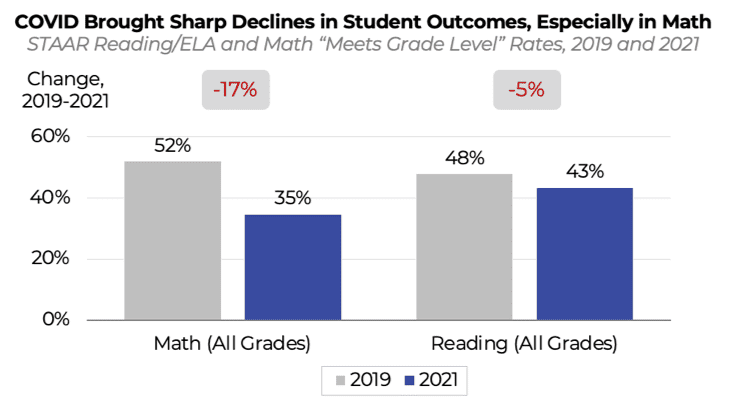
In fact, there was no subject in grades 3 through 8 in which more than 50 percent of students met grade level. At the high school level, English I and English II were the only subjects that saw improvement and the only subjects across all grades with more than 50 percent of students meeting grade level.
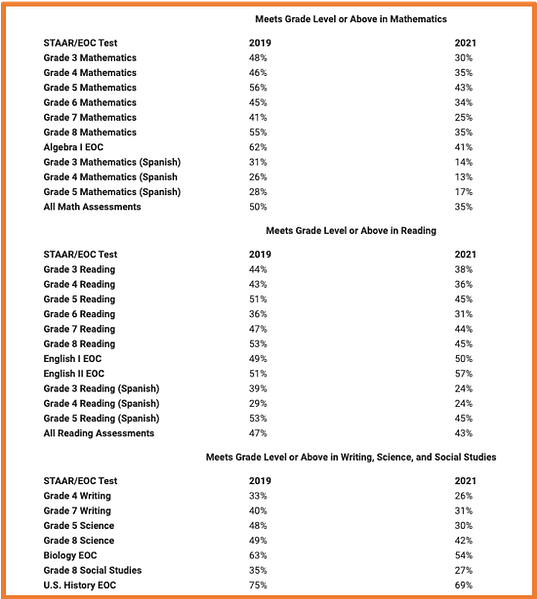
So, what should we make of these results? It is easy to dismiss the results as telling us what we already knew: students experienced significant learning loss during the pandemic. However, this data is important for schools to roadmap what will be a multi-year recovery effort. Student-level results also allow parents to see where their student is struggling and work with their teachers on a path forward.
Here are our top 3 takeaways:
1) Typically a bright spot, Texas saw the greatest degree of decline in math.
As shown above, the largest declines in proficiency were seen in mathematics across all grade levels. Math was an area where — pre-pandemic — Texas was seen as nationally competitive. From a TEA press release on the Nation’s 2019 Report Card:
“Nationally, scores for 4th grade mathematics have been relatively flat since 2007. However, Texas’ 4th grade students have consistently outperformed the national average for more than a decade, continuing the trend with a statistically higher average in 2019. Texas African American, Hispanic, and Anglo students performed in the top 10 nationally in 4th grade math, with African American students ranking first among their peers in all states.”
This year, only 35 percent of students met grade level on math exams and 43 percent met grade level in reading. This is down from 50 percent and 47 percent respectively in 2019. Math scores in early grades have historically been a bright spot for Texas, but the decline in 3rd Grade math performance across all student groups is staggering.
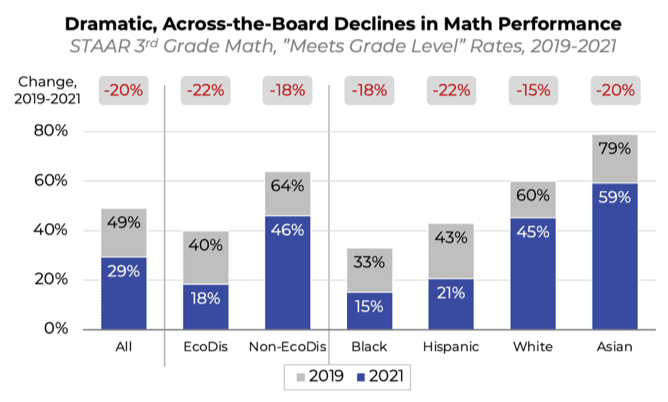 Another concerning data point that stands out in the math results is the decline in Algebra 1 proficiency. In 2019, 62 percent of students taking the Algebra 1 exam met grade level compared to 41 percent in 2021.
Another concerning data point that stands out in the math results is the decline in Algebra 1 proficiency. In 2019, 62 percent of students taking the Algebra 1 exam met grade level compared to 41 percent in 2021.
2) Schools with a higher percentage of students learning virtually saw even worse outcomes than schools that taught most students in person.
Unsurprisingly, the method of instruction (in person vs. virtual) had a significant impact on student outcomes. Districts with a higher percentage of students learning virtually experienced a greater degree of decline while districts with the highest percentage of in-person learners largely avoided any learning declines in reading. As noted by Commissioner Morath, the effort by statewide and school district leadership to get students back in the classroom potentially prevented an even greater decline in achievement:
“Thankfully, from early on, Texas prioritized the availability of in-person instruction during this tremendously difficult year. When students come into Texas public schools, they are well-served by Texas educators—a fact that these scores confirm. But it is also painfully clear that the pandemic had a very negative impact on learning. I shudder to consider the long-term impact on children in states that restricted in-person instruction.”
From the TEA 2021 STAAR Analysis:
3) The pandemic widened pre-existing achievement gaps for economically disadvantaged and minority students.
While the disruptions were felt across all student groups, the impact of the pandemic has been disproportionate and that is certainly true in our schools. Economically disadvantaged and minority students experienced greater degrees of decline in reading and math than their peers.
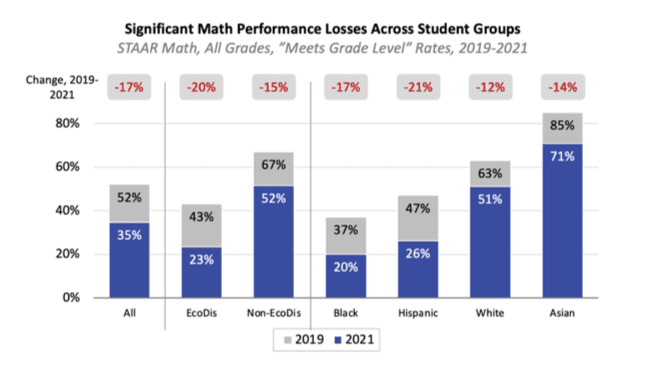
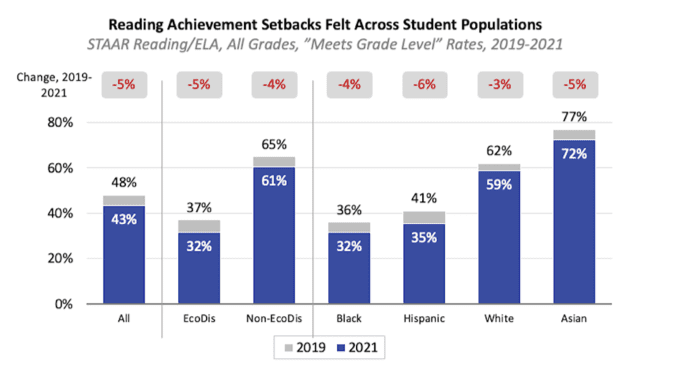 The troubling Algebra I results mentioned earlier are even more concerning when broken down by student groups. Algebra I is in many ways the gateway to advanced math—the sooner students master Algebra concepts, the sooner and more likely they will successfully move on to college-level math.
The troubling Algebra I results mentioned earlier are even more concerning when broken down by student groups. Algebra I is in many ways the gateway to advanced math—the sooner students master Algebra concepts, the sooner and more likely they will successfully move on to college-level math.
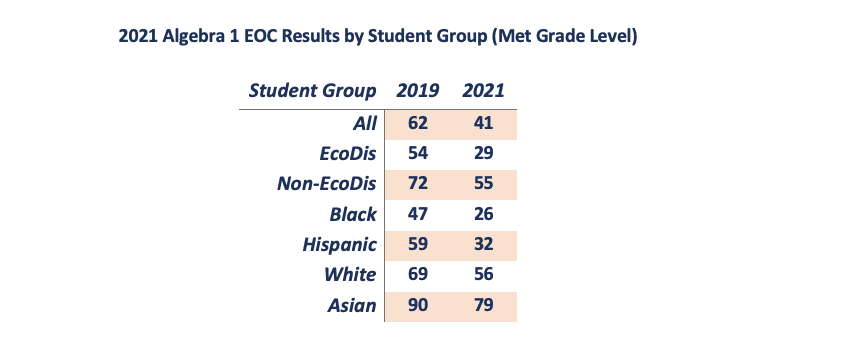 What gets measured, gets fixed
What gets measured, gets fixed
The truth is that, even before the pandemic, Texas faced a dire situation. While Texas is ranked 7th nationally in 4th Grade math, according to the Nation’s Report Card, 6-in-10 Texas fourth graders were not proficient in math, and 7-in-10 could not read at grade level with wide gaps in educational attainment linked to race, ethnicity, and income.
We cannot accept returning to the pre-COVID status quo. With good data and strategic investments, we can close the gaps that have existed far too long in our education system. The Legislature met funding commitments set forth in HB 3 and billions of federal funds are available, so students should have access to the kind of evidence-based practices we know will work to address the slide, such high-dosage tutoring efforts and expanded instructional time. HB 4545 gives schools the tools and funding necessary to accelerate student learning, but school leaders must also opt into additional programs like the Teacher Incentive Allotment and Additional Day School Year to put their students on a better path forward for the long-term.
Texas’ STAAR test, which provides results to parents, teachers, students, and lawmakers, creates the transparent conversation around how we as a state close performance gaps between historically marginalized communities.

